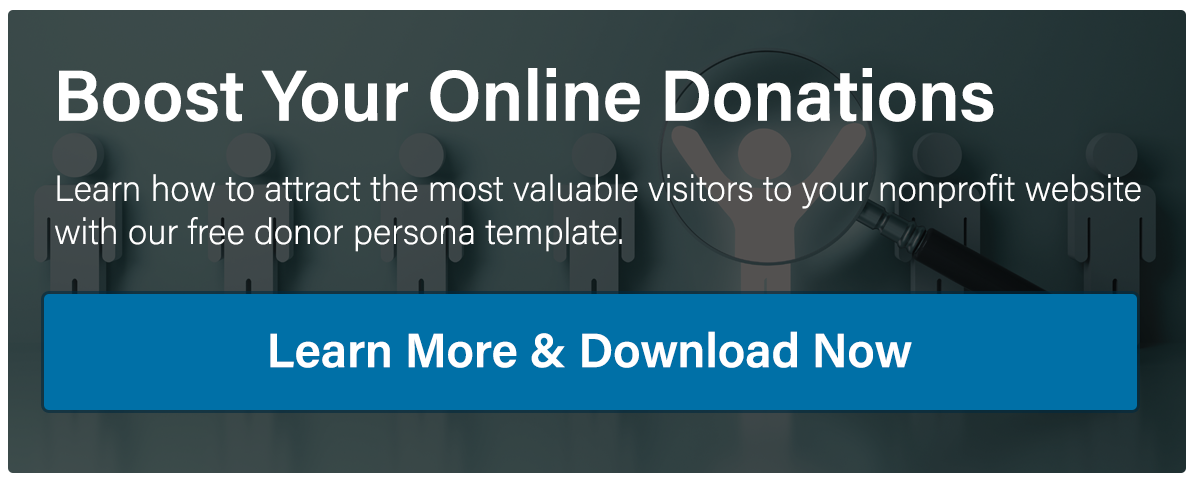A Nonprofit's Guide to Creating Donor Persona Profiles

If you're like most nonprofit marketing and development directors, increasing the results of your fundraising efforts is high on your to-do list.
Understanding your donors is key to a successful fundraising campaign.
But how do you go about understanding your donors?
By creating donor persona profiles, of course!
In this article, we'll outline what donor persona profiles are and provide a step-by-step guide on how to create them.
And best of all we have a free donor persona template for you to download to make getting started even easier.
Stay tuned - your most successful fundraiser is just around the corner!
Donor Personas
Your donor personas are semi-fictional portrayals of the people you expect to donate to your organization. You are taking your target audience and personifying them by creating a profile that contains their lifestyle details. You create donor persona profiles so you know who to target your marketing efforts on, and how to do it effectively.
Here's how to create your donor persona's profile:
Conduct Donor Persona Research
You create donor personas through research, surveys, and interviews of your target audience. To get the best results, you’ll research a mix of current members, volunteers, or donors and those outside of your contact lists that might align with your target audience.
So how do you find out details about your donor persona’s lifestyle and interests? Start out by conducting interviews and performing research using social media insights. We’ll go into detail about each of these.
Interviews
Your current donors are a great place to start for interviews because you want to find more people that are like them! When you talk with your current donors, it will help you find common donor types. For the interview process, consider all of your donors, whether they are one-time or recurring donors. You may learn valuable insight about both types that help you distinguish between the two types.
Questions to Ask
You want your interview to be as beneficial as possible, so here are some questions that will provide you with a lot of insight into your persona’s lifestyle and interests.
- How did they find out about your cause?
This question may sound generic, but it will provide you insight into what platforms your donor persona uses. Ask if they do research on a nonprofit before giving and if so how do they search. Throughout your interviews, you’ll notice common traits among your donors.
- What are their hobbies/interests?
This question is a good icebreaker, and it will inspire your future marketing efforts. Once you know what your donor persona enjoys doing in their spare time, you can plan events and fundraisers around those hobbies.
For example, if your donor persona expresses interest in your local sports team and attending their games, reach out to your local sports team’s marketing department and set up a fundraising event there. If your donor persona gets excited about attending a fundraising event, then he/she is more likely to spread the word about it!
Plus, you would have a high chance of increasing your fundraiser’s success because your donor persona would be doing something they enjoy while giving back to a cause they support.
- What inspires them to give?
This is key to ask your interviewees. Do they have a personal connection with your cause? Do they enjoy seeing how their donations make a difference in someone else’s life? Are they content where they are in life and want others to feel the same? Are they impressed with the hard work your nonprofit does and want to help you with your efforts? Whatever their answer may be, keep this in mind when creating content for your donor persona.
- What factors does a nonprofit have to have for them to donate?
The answers to this question will help you prioritize your marketing efforts. If they require that the nonprofit has an informative website, you may want to move to producing content and cleaning up your website to the top of your to-do list. Others may say that an active social media presence is a prerequisite. Find out what the majority of your donors think and go from there.
Other questions to ask to learn about their lifestyle and interests:
- What is their occupation?
- Do they have a family at home?
- How does a typical day in their life look?
These questions will help you break the ice and get your donors to provide you with a lot of insight. Remember that your donor is taking time out of their day to help you answer some questions, so make the most out of your time together.
Interview Tips
Here are some tips to make sure you get the most out of your interview!
- Let your donor do the talking.
The goal of this process is to get information from your target audience, not to inform them of your cause. Ask questions that make your interviewee tell a story, instead of answering generic yes or no questions.
Do you know how we always want to paint this ideal picture of ourselves to impress other people? Well if you ask your donor persona basic questions such as if they enjoy giving back to their community, then they will give you the answer you want to hear and won’t provide you with any real insight. Instead, ask them to tell you about the last time they donated and why they chose to do it. You are more likely to receive more truthful information and details you would have never thought about through your interviewee’s stories.
- Take small talk into consideration.
Before diving into your questions and after the interview, have a casual conversation with your donor about their day or a current event. Pay close attention to any specific details they share. Did they hear about something on Facebook? Did they stop by a local coffee shop before meeting up with you? Are they on their way to go pick up their kids from school after this interview? These small details can give you additional things to add to your donor persona profile.
Social Media Insights
When you are creating your donor persona profile, it is essential to know who interacts with your social media, when they do it, and what else they interact with. You can discover all of this and more through your social media insights.
- Facebook Audience Insights
Facebook Audience Insights will provide you with the “Lifestyle” demographics of your audience. They’ll let you know typical traits about people in a lifestyle category such as age, income, education level, specific interests, and much more. You’ll be able to include these lifestyle details in your donor persona’s profile.
- Twitter Analytics
Twitter Analytics provides similar insights that Facebook does. Comparing your data from Twitter with other social media insights will allow you to see which platform your donor persona prefers. You can also use this data with other social media insights to confirm the demographics of your donor persona. If they are different enough this validates the need for two personas.
You can also use stats on users who don’t follow you but have seen your tweets on their feed. So if there’s a field of interest that your organic audience has versus your current users, tailor your content to fit both of those needs.
- Instagram Insights
If you have a business Instagram account, you can see the impressions, reach, website clicks, views, and follower demographics from your profile. Additionally, they provide engagement insights on your posts.
They also have a discovery section. This section informs you how your posts were discovered (through search, hashtag, profile, location tag, etc.) It also shows your reach, meaning how many people saw your post. You can use these insights to see how your target audience is interacting with you and on Instagram in general (what hashtags they click on, what they search for, how they use Instagram to find causes, etc.)
Information to Include in a Donor Persona Profile
When you are researching your donors, you’ll come across a lot of information. So how do you decide what needs to go into your donor persona profile? Here are the details we recommend including in your donor persona profile for starters.
We'll provide you with our example of a sample donor persona profile to reference when you're making yours! It's broken up into 4 sections: who, what, why, and how.
Who?

Want to download this editable template? Click here to get access to your free copy.
Background
Include details about their occupation, education level, family life, marital status, and career path.
Demographics
You should have most of these details if you already had a target audience carved out. If not, you can pick up these details from interviewing or social media insights. Age range, gender, income level, and location are all details that fall into this category.
Identifiers
In this section, notate how he/she prefers to communicate with organizations. Options for this include social media, text, email, in-person, etc. This is also where you’ll record their preferred social media platforms if any are applicable.
Selecting Preferences
This is where you will record if your donor persona uses search engines to research nonprofits, and if so which ones. If they don’t use search engines to make their decision, then be sure to list how they select a nonprofit. Do they rely on word-of-mouth referrals from friends and family? Are they more likely to select your organization if their social media connections are talking about it? Your website, news/media outlets, and annual reports are other ways that your donor persona may narrow down their options. Whatever it may be, make sure you are aware of it!
What?

Want to download this editable template? Click here to get access to your free copy.
Goals & Challenges
Consider your donor persona’s life or career goals. Also take their life or career challenges into consideration. Next, relate these goals and challenges back to your organization. Think about how your organization can specifically help your donor persona meet their goals and overcome their challenges.
Why?

Want to download this editable template? Click here to get access to your free copy.
Real Quotes
In their profile, be sure to include quotes from donor interviews or social media reviews to show exactly the type of things your donor persona would say. These quotes can talk about their goals and challenges and how your nonprofit helps them accomplish and overcome those. They can also discuss why they specifically chose your organization for a donation or how they found your organization.
Common Objections
Ensure that you list any reasons that your donor persona would not donate to your organization so that you know what to avoid. Examples of objections are lack of transparency or being too aggressive when asking for donations.
How?

Want to download this editable template? Click here to get access to your free copy.
Marketing Messaging
Summarize how you would clearly and concisely explain your organization’s mission to interest this particular donor persona.
Name
The final step in personifying you target audience is to give them a name! It doesn’t have to be fancy, just make it something quick and catchy that your nonprofit team can remember. Referring to your target audience as “Donor Don” or something equivalent will humanize your persona.
Creating donor personas will help you meet your nonprofit’s marketing goal. That’s why it’s essential to conduct research and create detailed profiles so that you can save yourself time and money while producing successful results.
Do you want to create your nonprofit's own donor persona?
